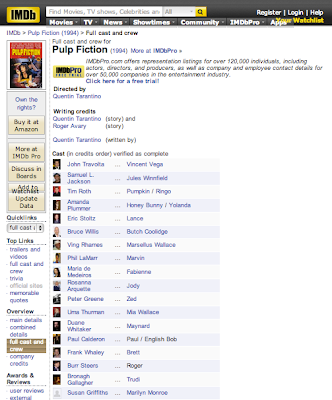Presentation for first crit
After our first crit, I received some very helpful feedback about how to keep in touch with the theme. Previously I had a separate idea of using text as background and overlaying it with key points, but I hadn't thought about putting this and the current layout plan together.
Fred made the point that I don't need as much text at the forefront of the spreads, as I was doing a lot of writing about the background and since I was aiming this publication at people who have an existing interest in the films/theme, they probably already know this information.
This allowed me to prioritise some other aspects of the film, a strictly postmodern analysis, the significance behind some quotes and the controversy caused by some of the themes or characters. I put the background information I had already written as the background text and made it pt. 6 Helvetica Light, deliberately small and unreadable to help the reader realise that the background text is not important, and not necessary to read.
To aid this concept further I avoided paragraphs or any way of breaking up the text, making it deliberately difficult to decipher.
There were some quotes from reviews and the film itself that I planned on laying over the top of the text but to do that I had to ensure that the text was of an appropriate weight and size to be much more readable than the background. Similarly, obstructing some of the background text implies that it doesn't need to be read (and in some cases can't). I chose to do this and to have some body of text just talking about key features and points in the film, but when doing this body copy I had to use some of the coloured sections behind the text to separate it from the background, as I can't have the text as heavy and large as with the quotes etc.
After completing the content I turned my attention to binding. I really wanted the content to be reflected in the style of the book and the nature of the binding. I did some research into slightly more innovative binding options.
This is a pretty interesting cover and binding method, given that the content of this book is based on woodwork. While I would love to try something like this sometime, I could see it taking up a lot of time that I would rather spend perfecting the content. In spite of the complexity of using wood, the binding is very simple and seems a bit too modern for my publication.
The intricacy of this string binding makes the book look delicate in spite of the hard back, and it is something I would like to experiment with, however, I want my publication to be more abrupt and forceful, so this style may not lend itself to my theme.
A basic perfect bound hard back would lend itself to my theme, it's quite demanding when partnered with the luminous yellow.
Had I chosen to make something in a leaflet or brochure, this would work extremely well and would allow me to create some sort of cryptic message within the production as well as the content.
While this isn't a theme that I would use for my own book, it has embodied the theme in every manner, even such details as the rolling papers for pages and the match lighting spine.
I chose to perfect bind my publication with a hardback, leaving the images and content to do the work. I didn't want the binding to distract the attention that I hoped the book would deserve. However, after considering the theme, I thought about changing it to a zine, making it much more casual, and in the end I tried to find a medium by still perfect binding the book but just with a paperback.
At the point at which I had made my binding decisions, I no longer had time to bind the book myself and so sent it to Hobs Reprographics for a paper back perfect bound version.





















































